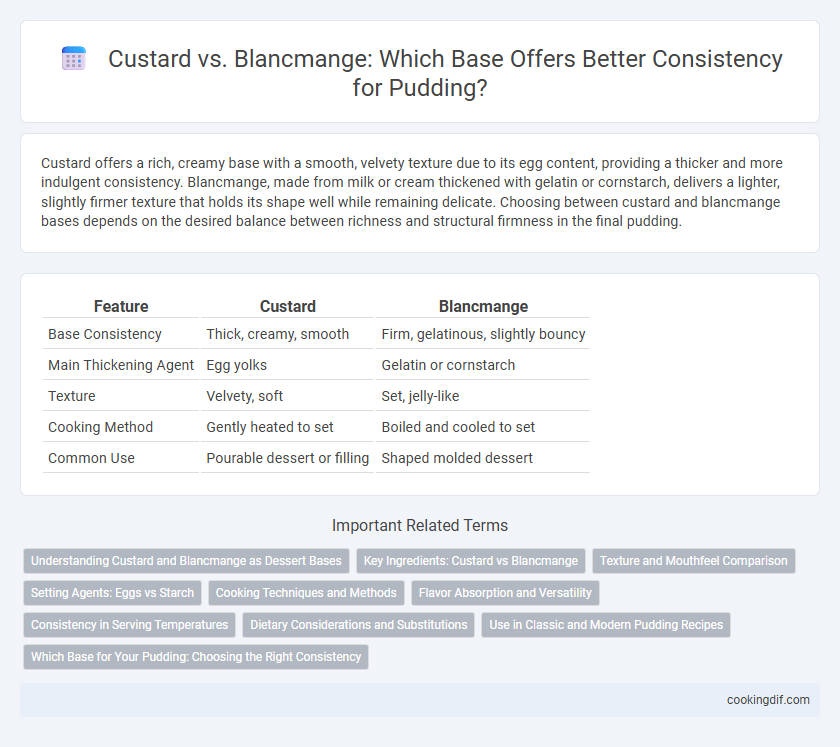Custard offers a rich, creamy base with a smooth, velvety texture due to its egg content, providing a thicker and more indulgent consistency. Blancmange, made from milk or cream thickened with gelatin or cornstarch, delivers a lighter, slightly firmer texture that holds its shape well while remaining delicate. Choosing between custard and blancmange bases depends on the desired balance between richness and structural firmness in the final pudding.
Table of Comparison
| Feature | Custard | Blancmange |
|---|---|---|
| Base Consistency | Thick, creamy, smooth | Firm, gelatinous, slightly bouncy |
| Main Thickening Agent | Egg yolks | Gelatin or cornstarch |
| Texture | Velvety, soft | Set, jelly-like |
| Cooking Method | Gently heated to set | Boiled and cooled to set |
| Common Use | Pourable dessert or filling | Shaped molded dessert |
Understanding Custard and Blancmange as Dessert Bases
Custard, made primarily from eggs, milk, and sugar, offers a rich, creamy texture that thickens through gentle heating, providing a smooth and velvety base for desserts. Blancmange differs by relying on milk, sugar, and gelatin or cornstarch, creating a firmer, gel-like consistency that holds shape well and supports fruit or nut additions. Understanding these bases highlights custard's silky richness versus blancmange's structured solidity, crucial for selecting the appropriate foundation in layering and flavor development in desserts.
Key Ingredients: Custard vs Blancmange
Custard relies on egg yolks and milk or cream as key ingredients, providing a rich, smooth, and creamy base with a velvety texture. Blancmange uses milk or cream, sugar, and a setting agent such as gelatin or cornstarch, resulting in a firmer, more gelatinous consistency compared to custard. The presence of eggs in custard gives it a thicker, custardy texture, while blancmange's starch or gelatin base creates a more structured and sliceable dessert.
Texture and Mouthfeel Comparison
Custard offers a rich, creamy texture with a smooth, velvety mouthfeel achieved through the careful coagulation of egg yolks and dairy, creating a thick yet tender base. Blancmange, traditionally made with milk, sugar, and gelatin or cornstarch, presents a firmer, more gelled consistency that holds its shape while delivering a silky, slightly gelatinous mouthfeel. The contrast lies in custard's luxurious softness versus blancmange's structured, jelly-like body, influencing their use in layered desserts and textural pairings.
Setting Agents: Eggs vs Starch
Custard relies on eggs as a natural setting agent, providing a rich, creamy texture due to the coagulation of egg proteins when heated. Blancmange uses starch, typically cornstarch or arrowroot, to thicken the mixture, resulting in a smoother, more gelatinous consistency. The choice between eggs and starch significantly influences the base consistency, with eggs offering a delicate custard firmness and starch delivering a stable, glossy set.
Cooking Techniques and Methods
Custard achieves its smooth, creamy base consistency through gentle cooking methods such as steaming or bain-marie, which prevent curdling by evenly distributing heat and slowly setting the egg proteins. Blancmange relies on starches like cornstarch or gelatin, cooked directly in milk or cream, which thickens upon cooling without requiring careful temperature control. The key difference lies in custard's protein coagulation providing a richer, silkier texture, while blancmange's starch gelatinization results in a firmer, more stable set.
Flavor Absorption and Versatility
Custard's egg-thickened base offers a rich, creamy texture that absorbs flavors deeply, enhancing the overall taste experience while Blancmange's gelatin or starch base provides a lighter, smoother consistency that holds flavor more subtly. Custard's dense structure allows for bold flavor infusion from vanilla, chocolate, or spices, making it ideal for robust desserts. Blancmange excels in versatility with its delicate texture, easily pairing with fruit purees or syrups without overpowering the palate.
Consistency in Serving Temperatures
Custard typically maintains a smooth, creamy consistency when served warm, allowing its egg-thickened base to remain fluid yet stable. Blancmange, often set with gelatin or cornstarch, achieves a firmer, gel-like texture that is best preserved when chilled, ensuring a clean, sliceable consistency. Serving temperature significantly influences the mouthfeel and structural integrity of both desserts, with custard excelling warm and blancmange preferred cold.
Dietary Considerations and Substitutions
Custard typically relies on eggs and dairy for its creamy base, which can pose challenges for those with egg or lactose intolerance, while blancmange often uses cornstarch or gelatin and milk alternatives, offering more flexibility for dietary restrictions. Substitutions in custard may include plant-based milks and egg replacers to maintain texture without allergens, whereas blancmange's base easily accommodates vegan and gluten-free options by selecting appropriate thickeners. Understanding these differences helps tailor pudding recipes to diverse dietary needs without compromising consistency or taste.
Use in Classic and Modern Pudding Recipes
Custard provides a rich, creamy base with a smooth texture ideal for classic puddings such as creme brulee and flan, offering a delicate egg-thickened consistency. Blancmange, made from milk, sugar, and thickening agents like gelatin or cornstarch, delivers a firm yet tender texture suited for molded puddings and modern variations that require stability without eggs. Both bases serve distinct roles in pudding recipes, with custard favored for silky decadence and blancmange chosen for its versatility and ease of flavor adaptation.
Which Base for Your Pudding: Choosing the Right Consistency
Custard offers a rich, creamy texture due to its egg-based composition, creating a smooth and silky pudding base that holds shape well when chilled. Blancmange, made from milk thickened with gelatin or cornstarch, provides a lighter, more gelatin-like consistency that sets firmer and is ideal for molded desserts. Selecting custard or blancmange as your pudding base depends on desired mouthfeel and setting properties for your recipe.
Custard vs Blancmange for base consistency Infographic

 cookingdif.com
cookingdif.com